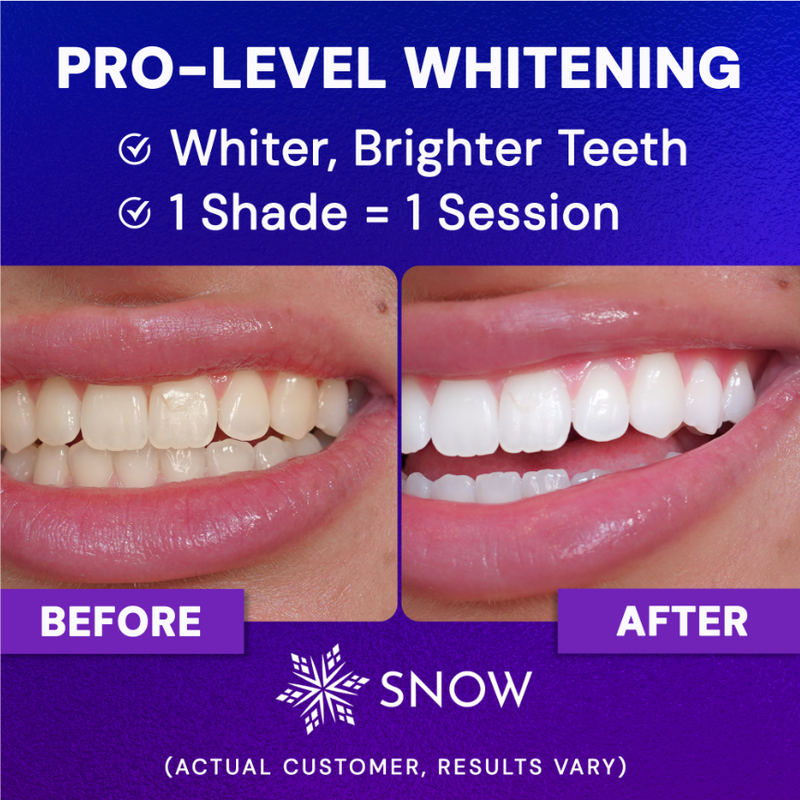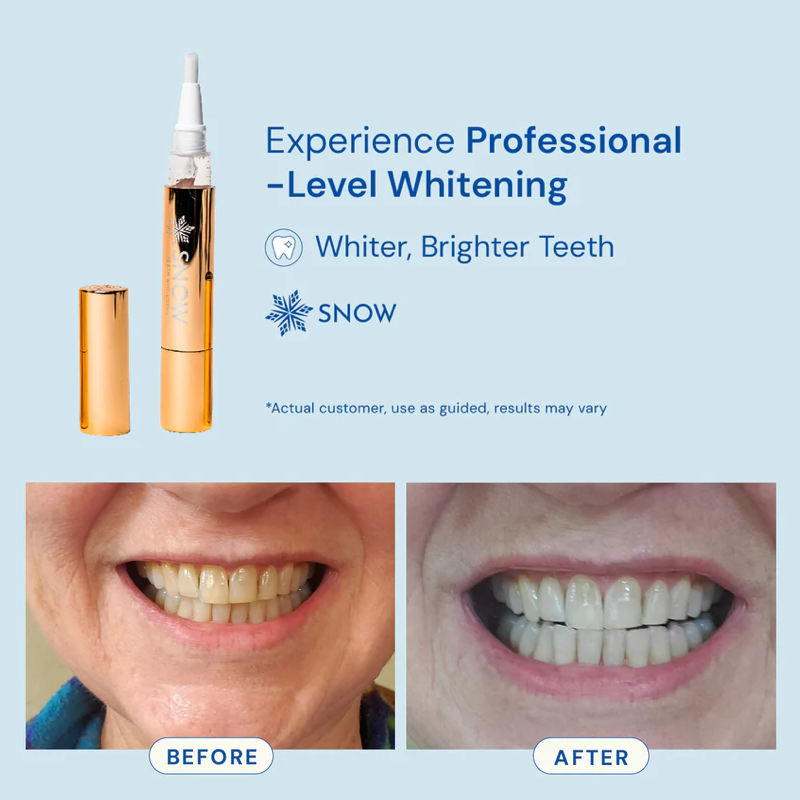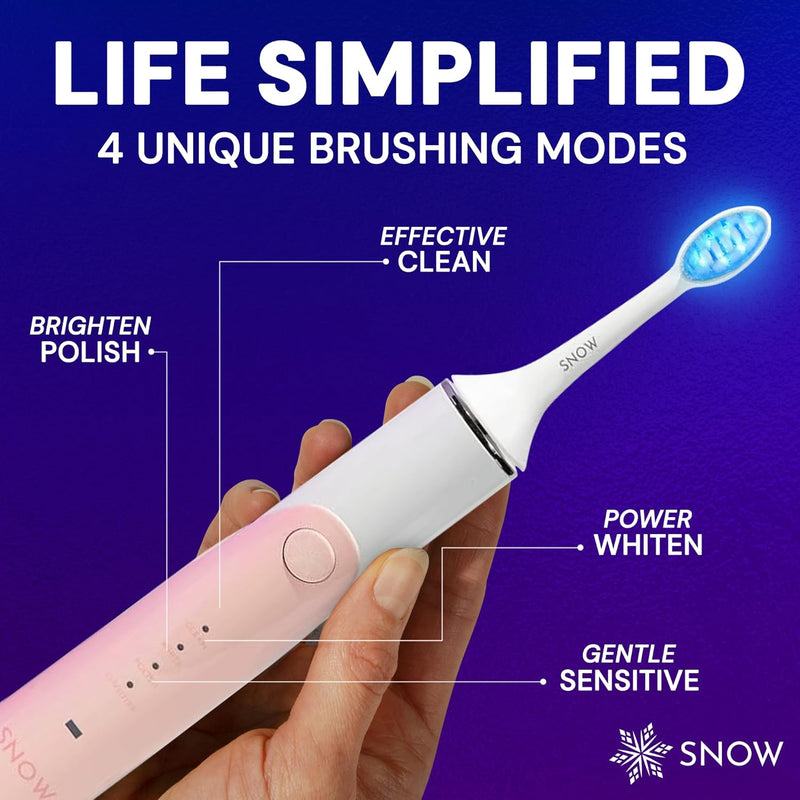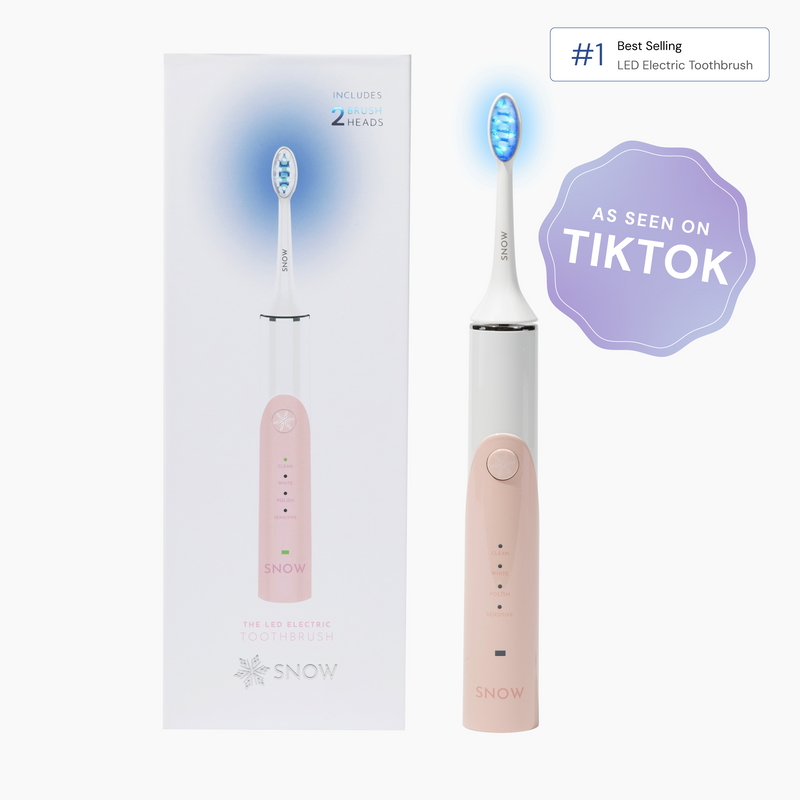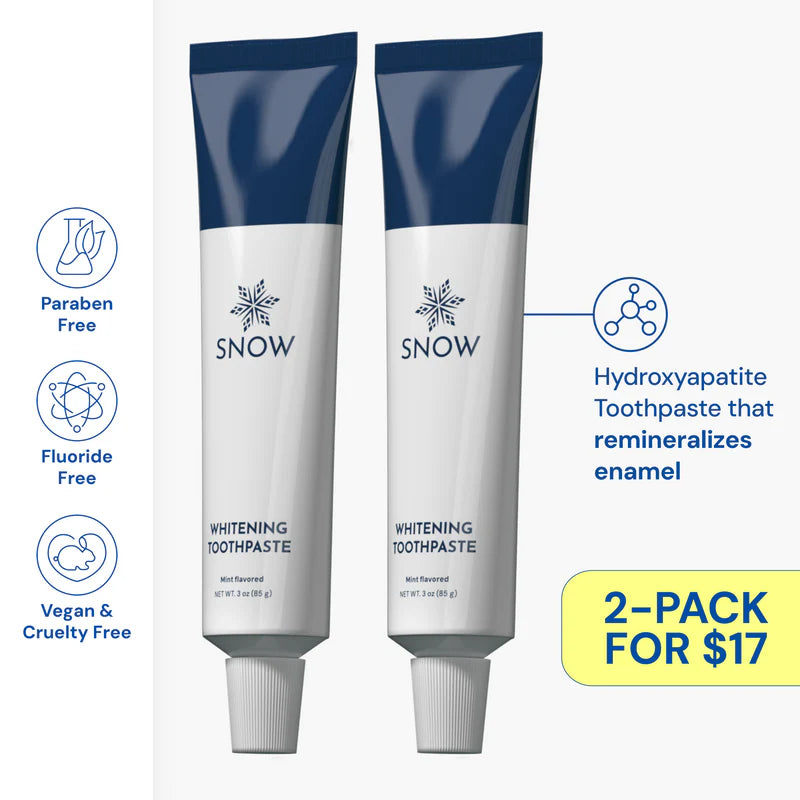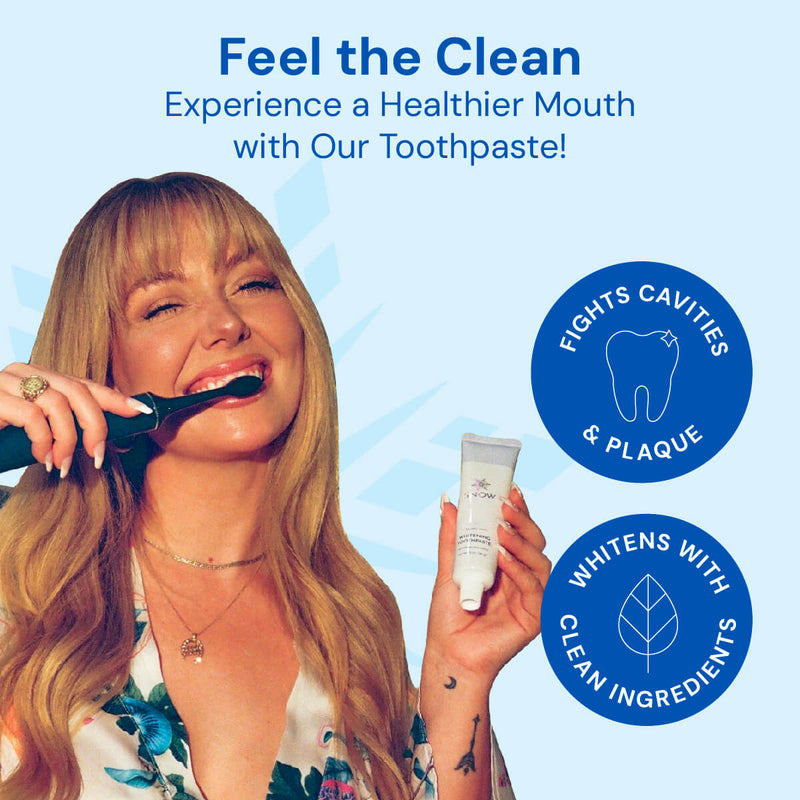Regularly replacing your toothbrush is essential for maintaining optimal dental health. But why change toothbrush every 3 months? SNOW has the answer!
Over time, toothbrush bristles wear down, reducing their effectiveness at removing plaque and debris from your teeth.
Additionally, old toothbrushes can harbor bacteria, increasing the risk of oral health issues.
In this article, we'll explore the importance of changing your toothbrush every three months and provide expert tips on maintaining a healthy oral hygiene routine.
From identifying signs that it's time for a new toothbrush to cleaning electric toothbrushes,
SNOW's comprehensive guide will help you achieve a brighter, whiter smile while safeguarding your dental health.
What this article covers:- Why Should You Replace Your Toothbrush?
- What to Consider When it's Time to Replace Your Toothbrush
- When You Need to Change Your Toothbrush Even Sooner
- Tips to Keep Your Toothbrush Clean
- What About Kids' Toothbrushes?
- How Do You Clean an Electric Toothbrush?
Why Should You Replace Your Toothbrush?
Wondering why it's crucial to replace your toothbrush regularly? SNOW has the answers.

Regularly changing your toothbrush, whether it's a manual bamboo toothbrush or our LED Teeth Whitening Electric Toothbrush, is essential for maintaining optimal dental health. Let's delve into the reasons why you should replace your toothbrush:
1. The Bristles Get Worn
Over time, the bristles of your toothbrush deteriorate, becoming less effective at removing plaque and debris from your teeth.
According to Real Simple, worn-out bristles won't clean your teeth as thoroughly, potentially leaving behind harmful bacteria and food particles.
2. Buildup Of Bacteria
An accumulation of bacteria on your toothbrush is inevitable, especially if it's not replaced regularly.
Using a contaminated toothbrush can reintroduce bacteria into your mouth, leading to oral health issues like cavities and gum disease.
Verywell Health states that replacing your toothbrush regularly helps prevent bacterial buildup and maintain oral hygiene.
3. Old Brushes Damage Teeth And Gums
As your toothbrush ages, it may develop sharp or frayed bristles that can harm your gums and enamel. To protect your dental health, it's essential to use a toothbrush with soft, intact bristles.
4. Keeping It Fun
Regularly changing your toothbrush allows you to experiment with new designs, colors, and features, making brushing a more enjoyable experience. Fun toothbrushes can motivate you to maintain proper oral hygiene habits.
5. Prevent Illness
An old toothbrush can harbor harmful bacteria and viruses, increasing the risk of infections and illnesses.
By replacing your toothbrush every few months, you can minimize the spread of germs and safeguard your health.
In the following sections, we'll explore additional factors to consider when replacing your toothbrush and provide expert tips on maintaining optimal oral hygiene.
What to Consider When it's Time to Replace Your Toothbrush
Curious about when to replace your toothbrush? SNOW has you covered. Here's what you should consider:
Frequency Of Use
Brushing twice a day? Your toothbrush will wear out faster than if you brush once daily. For a durable and effective solution, try SNOW's LED Teeth Whitening Electric Toothbrush.
Appearance
Regularly inspect your toothbrush for wear, such as frayed or splayed bristles.
When it's time for a replacement, upgrade to SNOW's Advanced Whitening Electric Toothbrush for a superior brushing experience.
Also, consider changing toothbrushes more frequently if you notice accelerated wear or if the bristles start to bend outward significantly.
Moreover, if you notice your toothbrush turning pink from potential bacterial growth, it's a clear indicator that it's time for a new one.
Illness
Just recovered from an illness? Swap out your toothbrush to prevent reinfection. Stock up on replacement heads for SNOW's Advanced LED Electric Toothbrush to ensure you're always prepared.
When You Need to Change Your Toothbrush Even Sooner
Occasionally, you may need to switch out your toothbrush or toothbrush head before the suggested three months.
This can be because you've gotten sick and the toothbrush has some bacteria on it that could reinfect you or you've dropped your toothbrush in something that you'd rather not take a chance on trying to wash off.
It's crucial to be attentive to certain situations that may require an immediate toothbrush replacement.
Let's take a look at some of the occasions you may need to change your toothbrush sooner than three months:
You've Recovered From Sickness
After battling an illness, it's essential to swap out your toothbrush promptly.
Specifically, when to change your toothbrush after strep throat or similar infections is immediately to avoid recontamination.
Doing so prevents the risk of reintroducing harmful germs into your mouth, supporting a faster recovery and maintaining optimal oral health.
Your Toothbrush Has Been Exposed To Unsanitary Conditions
If your toothbrush has been compromised by contact with unsanitary surfaces or substances, such as falling on the floor or sharing it with others, it's crucial to replace it immediately.
Ensuring a clean toothbrush environment is vital for effective oral hygiene and preventing potential infections.

Tips to Keep Your Toothbrush Clean
Ensuring the cleanliness of your toothbrush is vital for maintaining good oral health and maximizing its effectiveness in teeth whitening.
Here are some practical tips to keep your toothbrush clean and hygienic:
Don't Try Sterilizing The Toothbrush
While it may seem like a good idea to sterilize your toothbrush, methods such as boiling or microwaving can actually damage the bristles, rendering your toothbrush less effective.
Opt for gentle cleaning methods to avoid compromising its functionality.
Rinse And Air Dry After Use
After each use, thoroughly rinse your toothbrush with water to remove any toothpaste residue and food particles. Then, allow it to air dry upright in a well-ventilated area.
This practice helps prevent the growth of bacteria and fungi on your toothbrush, maintaining its cleanliness and efficacy.
Store It In An Open Place And Keep It Away From Other Toothbrushes
Store your toothbrush in an upright position in an open area away from other toothbrushes to promote airflow and prevent cross-contamination.
Avoid enclosed containers or covers that can trap moisture, as it creates an ideal environment for bacteria to thrive.
Implementing these simple yet effective practices will help ensure the cleanliness and longevity of your toothbrush, supporting your at-home teeth whitening efforts.
What About Kids' Toothbrushes?
When it comes to children's toothbrushes, SNOW recommends paying close attention to their condition and replacing them as necessary. Here's why:
Smaller Size And Faster Wear
Children's toothbrushes are typically smaller in size compared to adult toothbrushes. Due to their smaller size and the fact that children may brush more vigorously, their toothbrushes tend to wear out more quickly.
Importance Of Effective Cleaning
Effective cleaning is crucial for children's oral health, especially during the formative years. As children are more prone to cavities and dental issues, ensuring that their toothbrushes are in good condition is essential for maintaining proper oral hygiene.
If you want to ensure your children's teeth are protected and clean, check out our plant-based Kids' Manual Toothbrush.
Regular Monitoring And Replacement
Parents should regularly monitor their child's toothbrush for signs of wear, frayed bristles, or other damage.
As soon as any signs of wear become apparent, it's time to replace the toothbrush to ensure that their teeth are being effectively cleaned.
By staying vigilant and replacing children's toothbrushes as needed, parents can contribute to their children's dental health and support their at-home teeth whitening efforts.

How Do You Clean an Electric Toothbrush?
Cleaning your SNOW electric toothbrush is a breeze, ensuring optimal hygiene for your oral care routine.
Here's how:
Rinse The Brush Head After Each Use
After brushing, remove the brush head from your SNOW electric toothbrush and rinse it thoroughly under running water.
This simple step helps to remove any toothpaste residue and debris, keeping the brush head clean and ready for your next use.
Some users report that their electric toothbrush feels weird at first, but regular cleaning and familiarity with the vibrations can enhance the brushing experience.
Clean The Handle And Charging Base
Regularly clean the handle and charging base of your SNOW electric toothbrush as per the manufacturer's instructions.
Use a damp cloth to wipe down these surfaces and prevent the buildup of bacteria or other contaminants.
Following the manufacturer's guidelines ensures that your electric toothbrush remains hygienic and in optimal condition for effective teeth whitening.
Enjoy Easy Maintenance
SNOW electric toothbrushes are designed for easy maintenance, making it convenient to keep them clean. With simple steps and minimal effort, you can ensure that your electric toothbrush remains a reliable tool for achieving a brighter, whiter smile from the comfort of your home.
By following these cleaning tips, you can maintain the cleanliness and effectiveness of your SNOW electric toothbrush for long-lasting oral health benefits.
Conclusion
Regularly replacing your toothbrush every three months and adhering to proper hygiene routines safeguards your teeth and gums against potential damage and oral health complications.
A fresh toothbrush plays a pivotal role in maintaining optimal dental hygiene.
For additional guidance on teeth whitening and comprehensive oral care, explore SNOW's range of toothbrushes and oral hygiene products.
With SNOW's innovative solutions, you can achieve effective teeth whitening results while prioritizing your dental wellness.
Discover the transformative benefits of SNOW's teeth whitening products and elevate your oral care routine to new heights.
Explore SNOW's website for expert advice and premium dental care products. Start your journey towards brighter, healthier teeth today with SNOW's teeth whitening solutions.
If you want to learn more, why not check out these related posts:
- Toothbrush Hurt My Gums
- Best Electric Toothbrush for Small Mouths
- Bamboo Toothbrush Benefits
- Tongue Scraper vs. Toothbrush
- Soft vs. Extra Soft Toothbrush
- Electric Toothbrush Round Head vs Oblong
- Bamboo Toothbrush Mold
- Are Bamboo Toothbrushes Good for the Environment?
- How to Clean Toothbrush
- When to Change Toothbrush After Being Sick
- How to Clean Electric Toothbrush
- Does Electric Toothbrush Clean Better?
- Can Your Toothbrush Make You Sick?
- Benefits of Electric Toothbrush
- How Often to Replace Electric Toothbrush













































